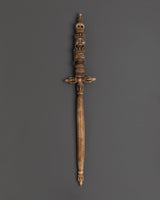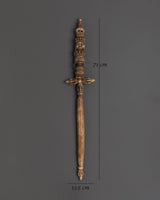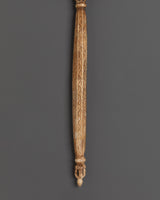







Tibetan Ritual Phurba Dagger | Spiritual Protection Tools

100% AUTHENTIC

HANDMADE

FREE SHIPPING
Handcrafted Tibetan Ritual Phurba Dagger | Ritual and Meditation Tool
--------------------------------------------
Size: 71cm(Height) x 13.5cm(Width)
Weight: 0.65kg
Materials: Ethically Sourced Buffalo Bone
--------------------------------------------
About The Ritual Item :
The Tibetan Ritual Phurba Dagger is a sacred spiritual tool, precisely designed to assist in meditation, spiritual rites, and defense. This beautiful dagger, which measures 71cm in height and 13.5cm in width, features an ethically sourced buffalo bone inlay. The Phurba is revered for its cultural and ritual significance, symbolizing spiritual transformation, protection, and energy grounding during meditation. Its sharp, three-pronged blade symbolizes the removal of negative forces and is used in sacred rituals to seal and protect areas.
This handcrafted Tibetan Phurba Dagger is an excellent addition to any spiritual practitioner's collection, as it was made with great care and precision. The wooden base provides sturdy support, and the buffalo bone inlay adds a distinct and tactile finish to the piece. The dagger is a sacred tool for invoking positive energies and dispelling negativity, making it a must-have for Buddhists and other practitioners of Eastern spirituality. Whether used in rituals or displayed as a spiritual artifact, this Phurba symbolizes the power of transformation and protection.
This handcrafted bone Phurba dagger is ideal for advanced practitioners, spiritual healers, and collectors of Tibetan ritual artifacts. It boosts meditative energy and creates a protective spiritual field. It can be placed on a home altar, utilized in protection rituals, or included into Tantric ceremonies to promote energy grounding. Its impressive size lends gravitas to any sacred space, making it more than just a tool; it is also a symbol of spiritual authority and awakening.
Introduction To The Phurba :
The ceremonial dagger (Sanskrit: Kila; Tibetan: phurba) is essential for expelling evil and is considered especially effective in neutralizing the forces obstructing Tantric Buddhist practice. It has ancient origins, first appearing in the Indian Rg Veda as the core blade of the vajra used by Indra to destroy the primordial cosmic snake Vritra. Kila, a peg or stake in Sanskrit, was most likely associated with Vedic sacrifices. Meditation on the Vajrakila Tantra, an early Indian scripture first promoted in Tibet in the eighth century by Padmasambhava, one of the founding teachers of Tibetan Buddhism, is used to invoke the three-headed Vajrakila Buddha.
How to set up your own Buddhist Shrine?
Find a clean, quiet, and uncluttered spot
Set up an altar table, and cover it with an altar cloth that calls to you
Place your sacred item (statue, thangka, or a picture of Buddha) at the center


















